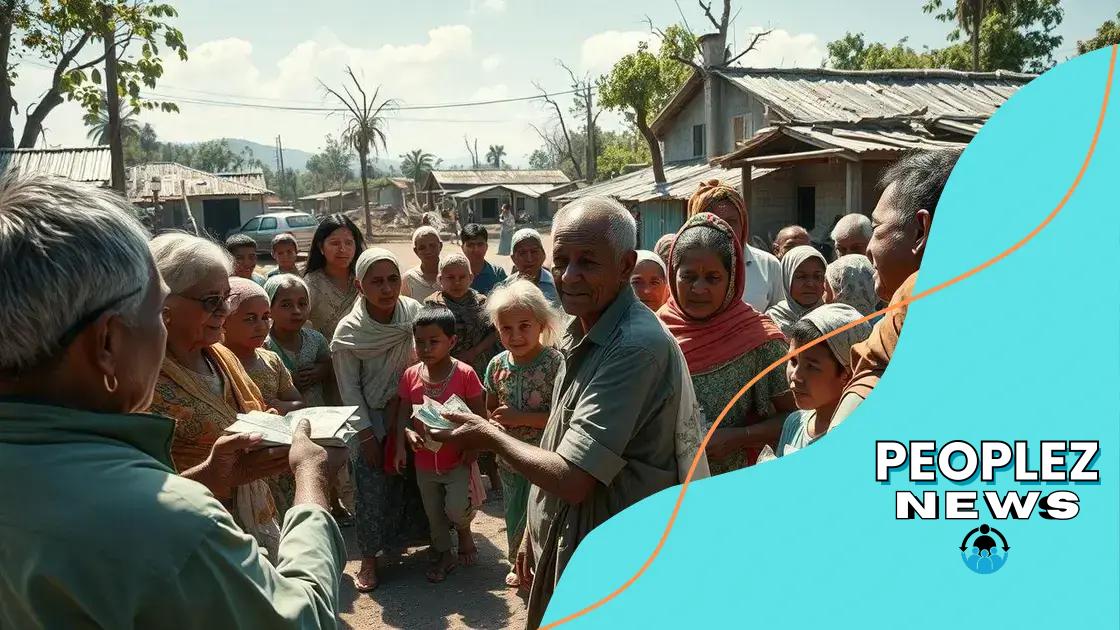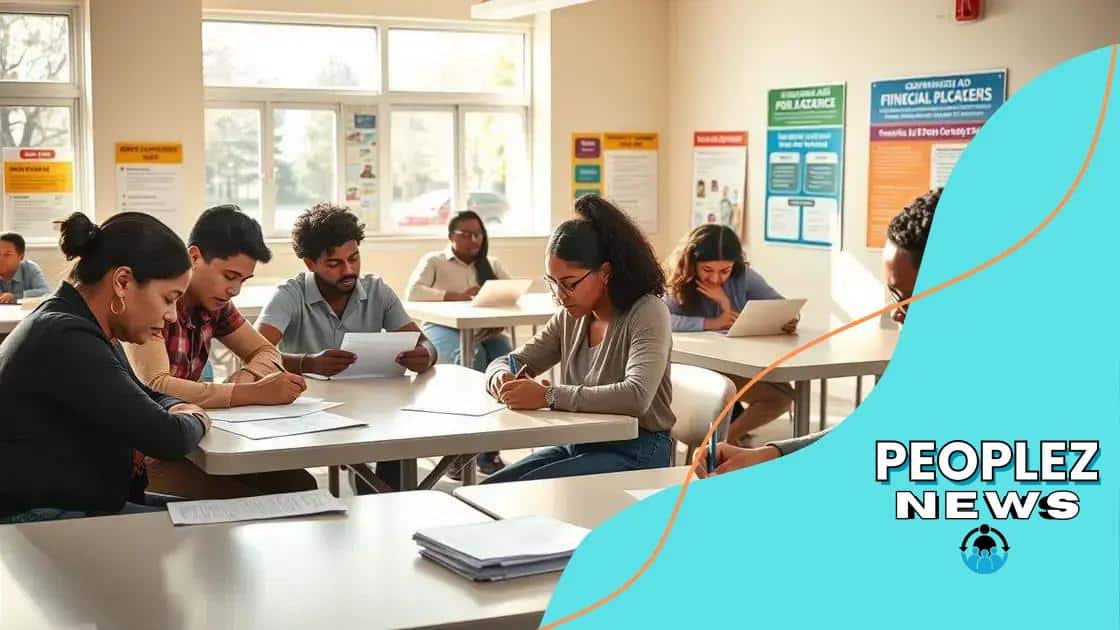Emergency financial aid in case of natural disasters

Emergency financial aid in case of natural disasters provides crucial support, including grants and low-interest loans, to help individuals and communities recover quickly from the impacts of disasters.
Emergency financial aid in case of natural disasters serves as a lifeline for affected communities. Have you ever pondered how timely assistance can help rebuild lives and restore hope? This article dives into the significance of such aid in the wake of calamities.
Understanding emergency financial aid
Understanding emergency financial aid is essential for communities facing the aftermath of natural disasters. This financial support aims to help individuals, families, and businesses recover quickly.
What is emergency financial aid?
Emergency financial aid refers to funds provided to those affected by catastrophic events. These funds can cover various needs such as housing, medical expenses, and basic living costs. It helps ensure that people can stabilize their situations and focus on rebuilding.
Types of aid available
Different forms of emergency financial aid exist, tailored to the unique needs of disaster survivors. Below are some common types of assistance:
- Government grants for immediate relief
- Low-interest loans for rebuilding efforts
- Non-profit organization assistance
- Health care coverage support
Each type of aid serves a specific purpose and can significantly impact recovery. For instance, government grants provide cash directly without repayment, easing short-term financial burdens.
In addition, many communities establish local funds to assist their residents in need. Such initiatives encourage neighbors to help one another, creating a supportive environment in challenging times.
How to access financial support
To access emergency financial aid, individuals usually need to apply through relevant agencies or organizations. These applications often require documentation of damages, income levels, and proof of residency. It’s crucial to act quickly, as funds can be limited and are typically distributed on a first-come, first-served basis.
Besides financial assistance, resources often include counseling and recovery workshops to help survivors navigate the recovery process. Local governments and NGOs frequently provide information on available resources, making it easier for disaster victims to seek help.
Understanding how to utilize these resources can significantly enhance the effectiveness of recovery efforts, making communities more resilient in the face of future disasters.
Types of aid available during natural disasters
When disasters strike, various types of aid are available to support those in need. Understanding these options is crucial for effectively accessing the help necessary for recovery.
Government Assistance
One of the primary sources of aid comes from government programs. These funds can include:
- Grants for immediate relief, covering essential needs like food and shelter.
- Low-interest loans to help rebuild homes and businesses.
- Temporary housing assistance to provide shelter for displaced families.
These government initiatives are designed to ensure quick support for those affected by disasters.
Non-Profit Organizations
In addition to government resources, many non-profit organizations play a significant role in disaster recovery. These groups often provide:
- Direct financial assistance to help families manage unexpected expenses.
- Food and clothing donations to support basic needs.
- Emotional support services to help individuals cope with trauma.
Non-profit organizations often work on the ground, ensuring that aid reaches those most affected.
Community Initiatives
Local communities may also establish funds to support their residents during tough times. These community initiatives often rely on donations from:
- Local businesses
- Residents
- Fundraising events
Such grassroots efforts can provide immediate relief and foster a sense of solidarity among community members. By working together, communities can help each other rebuild and recover, ensuring that no one is left behind.
Understanding the various types of aid available empowers those affected by natural disasters to navigate the recovery process effectively. The key is to explore all available resources and seek assistance as soon as it is needed.
How to apply for financial assistance

Knowing how to apply for financial assistance during a disaster is crucial for effective recovery. The process can seem daunting, but understanding the steps can help ensure support is received promptly.
Gather Necessary Documents
Before applying, it’s essential to collect all required documents. This may include:
- Proof of identity, such as a driver’s license or ID card.
- Documentation of damages, like photographs or repair estimates.
- Income verification, such as tax returns or pay stubs.
Having these documents ready can speed up the application process and make it more efficient.
Find Relevant Programs
Different organizations offer various types of assistance. Research local, state, and federal programs that fit your situation. Start with:
- The Federal Emergency Management Agency (FEMA) for federal assistance.
- Local non-profits and charities that may have specific funds for disaster relief.
- Your state’s emergency management office for additional resources.
Identifying the right programs is a vital step in securing the aid you need.
Follow Application Procedures
Once you’ve found the right programs, follow their specific application procedures. This may include:
- Submitting applications online, by mail, or in person.
- Filling out forms accurately to avoid delays.
- Meeting deadlines as many funds are limited.
Careful attention to the application process can significantly impact your chances of receiving aid. Persistence is important; keep track of your application status and follow up if necessary.
Ultimately, understanding the process and being proactive in seeking assistance can make a significant difference during challenging times. With the right approach, individuals and families can access the support needed to recover from a disaster.
Impact of financial aid on recovery efforts
The impact of financial aid on recovery efforts cannot be understated when communities face disasters. Financial assistance plays a pivotal role in helping individuals, families, and local businesses get back on their feet.
Accelerating Recovery
Financial aid provides immediate relief, which is crucial for survival in the aftermath of a disaster. This aid can cover essential needs such as:
- Temporary housing costs for displaced families.
- Basic living expenses, including food and childcare.
- Repair and rebuilding costs for damaged homes and businesses.
By addressing these urgent needs, financial aid helps communities bounce back faster from the effects of natural disasters.
Supporting Local Economies
When financial assistance flows into a community, it not only helps individuals but also supports local economies. The funds often lead to increased:
- Spending at local businesses, helping them thrive during tough times.
- Job creation as businesses begin to hire workers for repair and reconstruction efforts.
- Investment in community infrastructure, improving overall resilience.
Such economic boosts contribute to long-term recovery and growth, enabling communities to rebuild stronger than before.
Psychological Benefits
The availability of financial aid offers emotional relief to those affected by disasters. Knowing that help is accessible can lessen feelings of anxiety and hopelessness. Survivors who receive assistance often display:
- Higher levels of optimism about their recovery.
- Improved mental health outcomes due to reduced financial stress.
- Greater community solidarity as members support each other through the process.
This psychological support is just as important as the financial aid itself, helping to heal communities on multiple levels.
Overall, financial aid is not just about money; it plays a multifaceted role in alleviating immediate needs, fostering local economic growth, and supporting the mental well-being of survivors. Its impact reverberates throughout communities, facilitating a more effective recovery process.
Challenges in accessing financial support
Accessing financial support after a natural disaster presents several challenges. Understanding these obstacles can help individuals navigate the recovery process more effectively.
Complex Application Processes
The application process for financial aid can often be complicated and confusing. Many disaster survivors find themselves:
- Overwhelmed by paperwork and multiple forms to fill out.
- Uncertain about what documents are required for their specific situations.
- Facing language barriers that make understanding instructions difficult.
This complexity can discourage those in need from seeking the help they deserve.
Limited Resources and Availability
In the aftermath of a disaster, financial aid resources are sometimes limited. Many affected individuals discover that:
- Fund availability decreases over time, reducing access as recovery efforts progress.
- Specific programs may have financial caps based on demand, leaving some without assistance.
- Competition for available resources can be intense among community members.
This limitation on funding can create anxiety and frustration as individuals try to secure necessary support.
Awareness and Information Gaps
Another challenge is the lack of awareness regarding available financial support. Many people do not know about the resources that exist, which can lead to:
- Missed opportunities to apply for aid.
- A lack of outreach from organizations to inform the community of available assistance.
- Relying on word-of-mouth information that may be outdated or incorrect.
Improving communication about financial aid options is necessary for better access.
Facing these challenges can make the process of obtaining financial support feel daunting. However, knowing these obstacles allows individuals to be proactive in seeking assistance and encourages communities to work together in addressing these issues.
FAQ – Frequently Asked Questions about Emergency Financial Aid
What types of financial aid are available after a disaster?
There are various forms of aid, including government grants, low-interest loans, and support from non-profit organizations.
How do I apply for financial assistance?
To apply, gather necessary documents like proof of identity and damage assessments, then submit an application through the relevant agency.
What challenges might I face when seeking financial support?
Common challenges include complex application processes, limited availability of resources, and gaps in awareness about available aid.
How can financial aid impact my recovery after a disaster?
Financial aid can provide immediate relief, support local economies, and improve mental well-being by reducing stress associated with financial strain.





